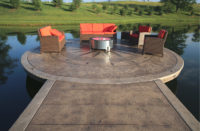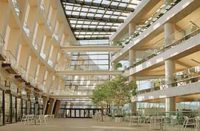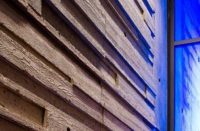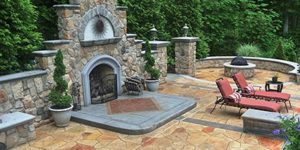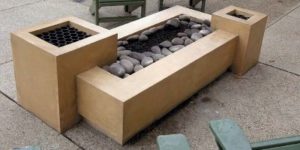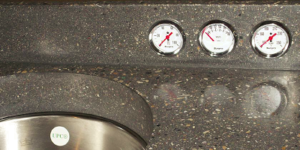Like an artist painting on a blank canvas, Mat Rogers of Flying Turtle Cast Concrete has created a showcase home that demonstrates his experience in design and his ability to use concrete in unexpected ways.
After two years of work, the spectacular result — his own home, at 1013 Enslen Ave. in Modesto, Calif. — is a two-floor, 4,400-square-foot showplace that cost about $1.3 million to create over a 1,700-square-foot home that had been largely torn down. Decorative concrete plays a starring role indoors and out. It’s featured not only in concrete floors, countertops, sinks and fireplace surrounds, but also in three tables and the bed frame and end tables in the master bedroom.
“It was an opportunity to come full circle and integrate all the ideas and skills I had learned and honed with concrete over the last 10 years,” Rogers says.
 Rogers had worked as a design-build contractor for a dozen years prior to founding Modesto-based Flying Turtle. His aim at the Enslen house was to show that concrete could look modern, yet warm and inviting at the same time. Architects and designers who have toured the home don’t even realize some of his creations are made of concrete, he says.
Rogers had worked as a design-build contractor for a dozen years prior to founding Modesto-based Flying Turtle. His aim at the Enslen house was to show that concrete could look modern, yet warm and inviting at the same time. Architects and designers who have toured the home don’t even realize some of his creations are made of concrete, he says.
“The front view of the house is quite stunning,” he says. “The color palette is subtle, and the combination of the stone, the stucco walls, and knotty cedar eaves give the steep stone buttress design a welcoming warmth.”
Exterior concrete at the home includes an in-ground pool, large patio and outdoor shower. Three large second-story decks are outfittted with hand-forged metal rails. Integrated concrete planters and a floating bench can be found in the backyard. The pool deck was detailed without the use of rounded joint cutters. “We ended up with an effect of a smooth carpet,” Rogers says. “We poured 2-foot strips of concrete, left the edge sharp and poured against that, infilled the grid and then went back with the saw blade. So it’s not a deep cut — it’s a more refined and smooth look.”
Concrete throughout
Other features of the house incorporated decorative concrete as well.
Living room/dining room fireplace and coffee table: The double fireplace was one of the most challenging projects in the entire house. The dining room side is an artistic mixture of concrete, walnut columns and glass panels. The living room side is simpler, with large square grids of concrete surrounding a black frame around the firebox. Visitors can enjoy the fire and put their feet up on a glass-topped, cast-concrete coffee table, which was ground to reveal sand and fossils. The coffee table features two panels that appear to be falling away from each other in a V shape, connected by an antique chain embedded in the slabs.
Kitchen: The concrete island features a band of walnut color, which was made by leaning the mold and pouring black, then walnut brown, then more black concrete into it, letting it set up for about half hour between pours. Rogers says the three different layers gave him the depth of color he was looking for.
Once the slab came out of the mold, he used a diamond grinder to expose sand and add an extra layer of interest. Two inlaid fossils were glued into the mold at the color shift between brown and black.
The island appears to be floating, and it’s one of the many “wow” attractions in the home.
Rogers also made a breakfast buffet table in a Frank Lloyd Wright style, integrating concrete and solid walnut planks.
Dining-room wet bar: Rogers says the bar was designed to be a bit playful. It’s the only curve in the house. Behind the dark concrete countertop with integral sink are two large, convex concrete panels the color of burgundy wine, intended to suggest to visitors the feeling of looking into a barrel of wine. Three different coloring techniques were used — an integral color, an aniline dye and an acid stain — creating a deep, intense color that is brighter in the middle and muted at the outer edges.

indoors and out, in its showcase home, even in the bathrooms. Photo by Matthew J. Visser
Lower bath: The bathroom features wall panels of tan concrete that support a grid of 4-by-6 sandblasted fir timbers. The beige colors contrast with the wood tones in the concrete sink and backsplash.
Master bathroom: The fireplace, which incorporates concrete, walnut and metal, includes two metal band inlays that align with the walnut shelving and remind Rogers of a railroad track, an image that is reinforced when he hears trains go by at night.
The team at Flying Turtle used several forms of concrete throughout the house, including concrete and wire mesh in most of the wall panels, straight concrete for smaller countertops, such as those in the bathrooms, and glass-fiber reinforced concrete for some larger countertops. The large living room-dining room fireplace is a combination of straight concrete and GFRC pieces. The team occasionally troweled fiber into the back mix of concrete pieces for extra reinforcement.
“We use pea gravel in our face mix so we don’t lose the look of concrete,” Rogers notes. “We just like the depth and textural color variation aggregate helps to provide.”
While designing and building the house, Rogers learned that mixing stone with concrete was a money saver for exteriors. The stonework in front looks very high-end, and the job was far less expensive than doing it completely in concrete would have been. He also learned to ask other experts. “It’s always a good idea to have your ideas critiqued and reviewed by design professionals and friends,” he says. “I made some excellent adjustments based on outside input.”
Opening the house for tours has generated a lot of business for Flying Turtle. It’s also on the market, for $1.795 million. Rogers admits he’ll miss it. However, he says, he’s already moving on. “I’m looking forward to doing the next one!”
www.flyingturtleconcrete.com
